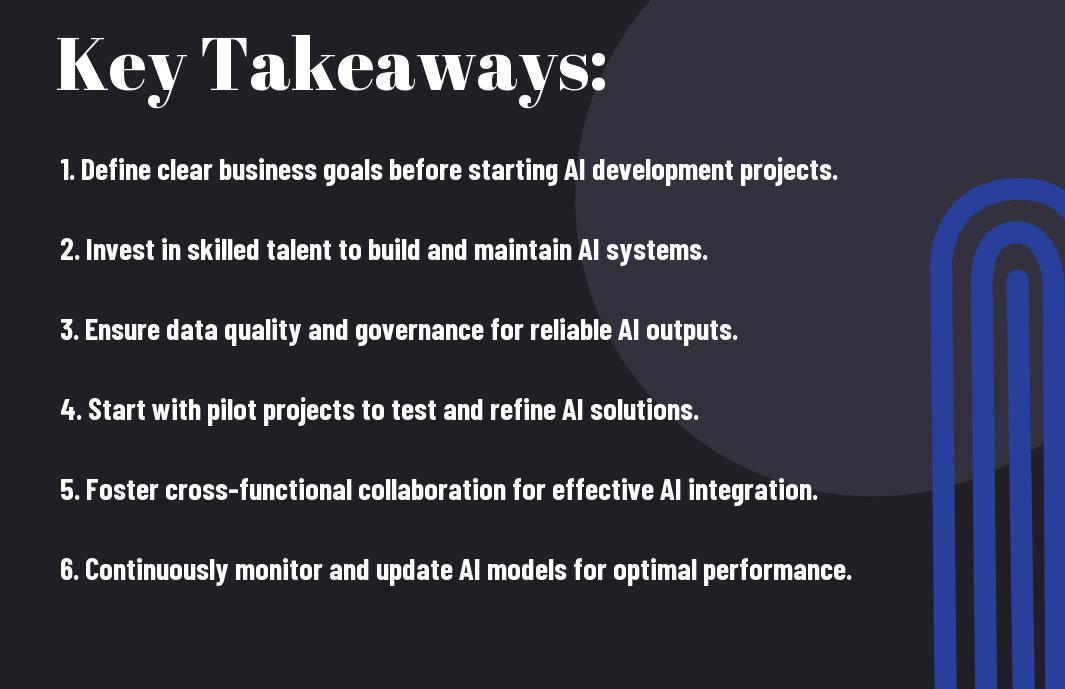You are begining on a transformative journey by adopting AI development for your enterprise. This innovative technology has the potential to enhance operational efficiency, drive informed decision-making, and foster competitive advantage. However, navigating the complexities of AI integration requires a well-structured approach. In this blog post, we will discuss important steps to ensure that your AI efforts lead to successful outcomes while mitigating potential pitfalls. Equip yourself with strategies that will not only boost your organization’s capabilities but also position you as a leader in the evolving digital landscape.

Mapping Your AI Strategy: Goals and Objectives
To effectively navigate the complexities of AI adoption, you must clearly define your goals and objectives. By establishing specific, measurable aims, your organization can focus on integrating AI technologies in ways that deliver tangible business outcomes. Whether it’s enhancing operational efficiency, improving customer experience, or driving innovation, understanding what you want to accomplish will shape your AI initiatives and steer resource allocation.
Defining Key Performance Indicators (KPIs)
Identifying key performance indicators (KPIs) is imperative to evaluate the success of your AI initiatives. These metrics should align with your defined goals, enabling you to track progress and make data-driven decisions. For instance, if your objective is to improve customer service response times, relevant KPIs might include average resolution time and customer satisfaction scores.
Aligning AI with Business Vision
Aligning your AI efforts with the overarching business vision fosters synergy across departments, ensuring that every project contributes to the strategic objectives. This alignment can be achieved by engaging stakeholders from various levels, encouraging buy-in, and demonstrating how AI initiatives fit into the larger picture. For example, if your company envisions leading the market through innovation, your AI projects should focus on developing new products or enhancing existing offerings with advanced analytics.
Understanding the overarching business vision allows you to pinpoint where AI can play a transformative role. Involving leadership ensures that AI initiatives reflect the organization’s long-term aspirations, whether through improving operational workflows or leveraging AI for competitive advantage. Communicate the potential benefits of AI within your company, illustrating how it can drive efficiency and foster innovation to meet your strategic goals. This alignment strengthens support across your organization and leads to a more cohesive and impactful AI strategy.

Building a Robust Data Architecture
Establishing a solid data architecture lays the foundation for successful AI initiatives within your enterprise. This involves creating scalable, reliable, and efficient systems that can handle large volumes of data while ensuring integration across various platforms. Utilize tools for data warehousing and real-time analytics, empowering your teams to make data-driven decisions that enhance operational efficiency and improve customer experiences.
Ensuring Data Quality and Accessibility
Your ability to achieve insightful AI outcomes hinges on maintaining high data quality and ensuring accessibility for your teams. Implementing automated processes for data cleansing, validation, and transformation will help you maintain consistency. Additionally, investing in self-service data access models guarantees that employees can readily obtain the data they need without navigating bureaucratic obstacles.
Implementing Effective Data Governance
Your organization benefits significantly from an effective data governance framework that dictates data management policies, roles, and procedures. By defining data ownership and establishing clear guidelines for data usage, your enterprise can mitigate risks associated with data breaches and compliance violations, all while improving data accuracy and consistency across departments.
Implementing effective data governance means not only setting oversight mechanisms but also fostering a data-driven culture throughout your organization. Engaging stakeholders from different business areas in governance discussions promotes ownership and accountability regarding data practices. Regular training sessions on data policies and best practices will reinforce their importance, ensuring that your workforce adheres to regulations like GDPR and HIPAA. Developing performance metrics to evaluate data quality and processing will help you gauge the effectiveness of your governance initiatives and encourage continuous improvement.
Cultivating AI Talent: Skills for Tomorrow
To harness the full potential of AI, your organization must cultivate a workforce skilled in various AI disciplines. This means equipping your team not only with technical expertise in data science and machine learning but also with imperative soft skills like critical thinking and creativity. Fostering an environment that encourages learning and adaptation will ensure that your talent stays ahead of the rapidly changing AI landscape.
Bridging the Talent Gap with Training and Hiring
Investing in both training existing employees and attracting new talent is imperative to close the AI skills gap. Implementing comprehensive training programs, mentorship opportunities, and partnerships with educational institutions can elevate your current workforce. Meanwhile, targeted hiring practices and internship programs can help bring fresh perspectives into your team, ensuring you have a diverse pool of skills required for successful AI implementation.
Fostering a Culture of Innovation and Experimentation
By promoting a culture of innovation and experimentation, your organization creates an environment where new ideas can flourish. Encouraging cross-functional teams to engage in pilot projects allows for practical applications of AI technologies. Celebrating small wins and learning from failures nurtures a growth mindset, which can lead to breakthrough innovations. Companies like Google and Amazon exemplify this by allocating resources to experimental projects, leading to groundbreaking products and services.
Businesses that prioritize an innovative culture often see high levels of employee engagement and creativity. Google’s famous “20% time,” which encourages engineers to spend a fifth of their work hours on personal projects, yielded remarkable products like Gmail and AdSense. This commitment to experimentation propels continuous improvement and adaptation. As such, empowering your teams to test, learn, and iterate not only enhances AI development but also drives company-wide evolution in processes and customer solutions.
Selecting the Right AI Tools and Technologies
Choosing appropriate AI tools and technologies is vital for your enterprise’s efficiency and effectiveness. With a plethora of options available, you must align your selection with your strategic goals and existing systems. Conducive platforms can propel your initiatives forward, whereas mismatched ones can lead to wasted resources and frustration. Dive deeper into how to streamline this selection process in Unlocking Success: 5 Steps for AI Strategy and Adoption at ….
Evaluating Platforms and Solutions for Fit
Your evaluation of AI platforms should focus on their ability to integrate with existing workflows. Investigate users’ feedback, feature sets, and support services before making a decision. A thorough comparison can uncover which solutions not only meet your needs but also enhance functionality. Pilot testing selected options may provide invaluable insight before a full-scale rollout, ensuring that the chosen platforms align with your operational dynamics.
The Importance of Scalability and Flexibility
The scalability of AI tools can significantly impact your enterprise’s capacity to grow. As demands increase, your chosen technology must support expanded workloads without compromising performance. Flexibility is also necessary; adaptable solutions allow for quick pivots in strategy or operations, accommodating shifting market dynamics. Selecting tools that excel in both areas ensures that your enterprise can evolve without unnecessary disruptions or technological constraints.
Scalability and flexibility are not merely features; they are vital for sustaining long-term success in an ever-changing business landscape. For instance, a cloud-based AI service can easily scale up as your data needs grow, eliminating fears of system overload. In contrast, rigid systems may struggle with new data sets or increased user activity, leading to inefficiencies. This adaptability empowers your enterprise to implement new strategies swiftly, allowing seamless integration of innovative capabilities as your objectives expand or shift. Ultimately, these qualities anchor your AI initiatives in a strong and resilient technological framework.
Overcoming Resistance: Change Management Strategies
Resistance to change is a common challenge companies face when adopting AI technologies. To mitigate pushback, it’s vital to implement robust change management strategies that facilitate smooth transitions and build organizational support. Acknowledge concerns and create an open environment for dialogue about AI’s potential impacts. You can learn more about the top 10 steps in adopting artificial intelligence that help engage employees throughout the process.
Engaging Stakeholders and Addressing Concerns
Involve key stakeholders early in the AI adoption process by actively seeking their input and addressing their concerns directly. Their insights can shape the project’s direction and influence buy-in across the organization. Organizing workshops or information sessions can foster collaboration and transparency, thereby uniting different departments under a shared vision of how AI will benefit the company.
Communicating the Value and Benefits of AI Adoption
Clear communication about the value of AI adoption can significantly enhance acceptance among employees. Highlight specific benefits such as increased efficiency, enhanced decision-making, and streamlined processes. Use data and case studies to illustrate past successes in AI0 implementations, ensuring that the workforce sees the tangible outcomes of these technologies.
When discussing the value and benefits of AI adoption, focus on how it can transform daily operations and improve individual roles. Case studies from various industries reveal how AI has reduced operational costs by an average of 30% and boosted productivity levels by up to 40%. Emphasize that AI isn’t meant to replace jobs, but rather to augment capabilities and foster innovation, enabling employees to concentrate on higher-value tasks. By illustrating the practical advantages backed by real-world evidence, you can create a compelling narrative for your workforce, ultimately leading to increased enthusiasm for the AI initiatives.
To wrap up
On the whole, adopting AI development is a strategic move that can significantly enhance your enterprise’s success. By following a structured approach that involves understanding your objectives, assessing current capabilities, and fostering a culture of innovation, you position your organization to leverage AI effectively. Additionally, investing in training for your team and continuously evaluating outcomes ensures you stay ahead in the competitive landscape. With commitment and clear strategies, you can unlock the full potential of AI, driving growth and efficiency in your business operations.







